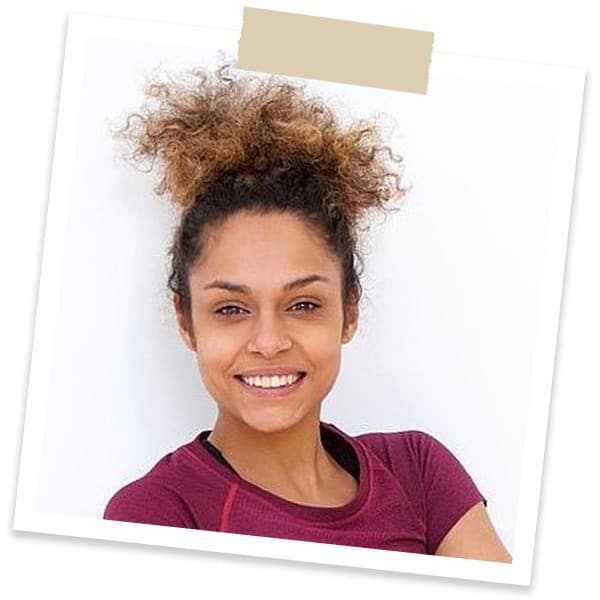Crunches are one of the best conventional and effective body weight exercises. If you want ripped abs, this exercise should be part of your routine.
So, how many crunches a day for ripped abs? It depends with you and your body. Some people need to do 50 crunches a day, while others 100 crunches a day. Still others go for a crazier number like 500 crunches a day. The number to remember is that doing 30 crunches per minute burns roughly 5 calories.
So, what’s my experience with crunching? Some time back, I noticed my core was not as toned as before. I started with 20 crunches a day then increased the intensity to avoid workout plateau.
Remember that the number of crunches you do in a day depends on your level of fitness, fitness goals, weight, and age. However, as mentioned above, crunching doesn’t burn life-changing amounts of calories. An average person performing 30 crunches a minute only burns 5 calories. This is much lower than what you get when doing other body weight exercises or using a machine.
So based on that average, you can start figuring out the number of crunches you need to start pumping to achieve your fitness goals. For example, if your goal is to burn 100 calories a day, you will need to perform at least 600 crunches. Crazy, I know. Understandably, not many of us can perform 600 crunches in 20 minutes, and the idea isn’t that appealing.
So, why are many people still doing crunches? Well, there’s a secret, shh…
Switching between variations can help you burn more calories. More on this below.
Are Crunches Good for Your Abs?
Do crunches work your abs or just cause pain on your neck? Truth is, crunches will do either depending on how you perform them.
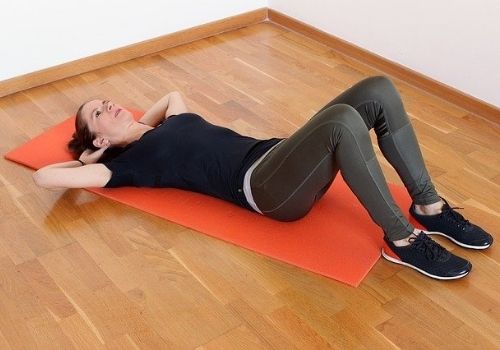
Failure to use proper technique and posture will only cause you more anguish and pain than work your abs. So, proper form is key. Trainers have also designed crunch variations to help you target more muscles with high precision and burn more calories.
Before going into the variations, let’s first learn how to do the standard crunches in proper form and then discuss the muscles worked by doing crunches.
How to Do Crunches: Step by Step Guide to Performing the Basic Crunch in Proper Form
Inspect the surface where you will do your crunches. Choose a flat floor or ground and make sure it is comfortable. You can enhance your comfort using a yoga mat instead of lying on a bare hard floor.
Step 1
Lie flat on your back and bend your knees so that your feet are flat on the floor. Place your hands behind your head with your eyes gazing to the roof. Alternatively, you can place your arms across your chest or behind your neck.

Step 2
Inhale and hold your breath, tighten your core to create pressure, and engage your abs and oblique muscles.
Step 3
Lift your shoulder blades off the floor slowly in a controlled motion while working hard not to curve your back. Exhale slowly on your way up.
Make sure your lower back maintains contact with the floor throughout the exercise. Avoid curving your neck, keep it straight with the chin about a tennis ball away from the chest. Hold for 2-3 seconds before lowering.
Note: Crunching halfway is more effective on the abs than raising to a sit-up. Raising to an almost sitting position will engage the hip flexors and reduce the engagement of the abs and obliques.
Step 4
Lower your shoulders back to the starting position in a slow and controlled motion. At the bottom, pause before you raise again.
This prevents you from using momentum instead of muscles to raise and prevents injury. Generally, rushed repetitions are not effective.
You should aim for 3 sets of 10-12 repetitions.
Hint: Crunches don’t come in a one-size-fits-all package. You should try to assess your personal ability to perform a certain number of sets and slowly add the number of sets as you progress. They can be performed up to 6 times a week
What Muscles Do Crunches Work?
This is an isolation exercise which targets specific muscles. Crunches mainly work your core muscles, but when performed in variations, it can target more muscle groups at the same time.
1. Rectus Abdominis and Obliques
Different variations of crunches will target different muscle groups with varied intensity. However, crunches in all its variations have a common emphasis on your rectus abdominis (the “six-pack” muscles) and the obliques, both interior and exterior.
Crunches engage these muscles intensely both in the upward and downward movement. Crunching frequently will excellently fire up your entire core and leave you with a well-toned trunk musculature.
2. Upper Back, Neck, and Shoulder and Hip Muscles
These groups of muscles are especially targeted using crunch variations that involve twisting of your core in right or left sides during crunches.
In some variations involving leg movements like the reversed crunch, scissor and vertical crunches, the exercise specifically targets your hip, lower back, and neck muscles.
Types of Crunches
Fitness professionals have come up with several variations from the original crunches to help you target more muscles effectively. Here are some of the variations and the muscles they target.
1. Bicycle Crunch
This variation is an outstanding choice because it effectively strengthens the core muscles. It is one of the best for working your rectus abdominis.
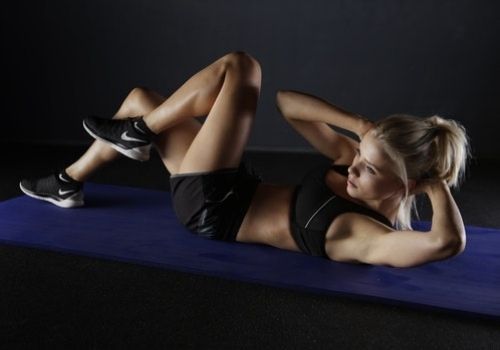
Step 1:
Lie flat on your back and place your fingertips behind your head. Avoid lacing your fingers. Inhale and hold your breath as you create tension on your abs.
Step 2:
Raise your knees and pull them towards your chest as you raise your shoulder blades off the floor. Let your head and neck maintain a neutral position. Don’t use your hands to pull your head or neck.
Step 3:
Simultaneously straighten your left leg while keeping your right leg bent with the knee up and then twist your upper body to the right to take your left elbow towards the right knee. Make sure to gently twist your entire core, arms and shoulders.
Step 4:
Alternate the sides by straightening your right leg and pulling your left knee close to your chest. Do this as you turn your upper body to the left so that your right elbow moves towards your right knee. Aim for 10-12 repetitions for each side.
You should do all these motions at a controlled pace for efficiency. Quick movements will not yield the required results.
2. Reverse Crunch
This type of crunch is designed to target your abs and obliques, both internally and externally. By extension, it also hits the hip and glutes muscles (buttocks). In reverse crunch, you will involve your legs more than your upper body.
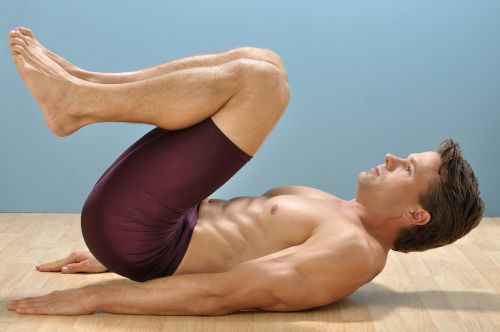
Step 1:
Lie flat on your back, face-up, hands on the floor with palms facing down. Put your legs together.
Step 2:
Slowly raise your legs and bend the knees to pull them towards your chest and proceed to push your legs up so that your waistline is raised off the floor. Pause for 2-3 seconds.
Step 3:
Lower your legs slowly back to the starting position. In the consequent repetitions, do not allow your heels to touch the floor. Hold them a few inches above the floor and repeat the raise. Aim for 3 sets of 12 repetitions.
3. Vertical Crunches
Aside from the rectus abdominis, this type of crunches also targets the hip muscles. It is a variation where you perform the standard crunch with legs raised and held up perpendicular to the floor.

Step 1:
Lie flat on your back and extend your legs straight in the air. Try to raise them 900 from the floor and hold them up.
Step 2:
With your fingertips behind your head or neck, raise your shoulder blades off the floor making sure your head and neck remain in a neutral position. Hold at the top for 1-2 seconds.
Step 3:
Slowly lower your shoulders back to the starting position. Pause for 2-3 seconds before going for the next repetition to make sure you’re using muscles not momentum. Go for 3 sets of 12 repetitions.
Related: You can use an aerobic stepper for a comfortable more intense crunch workout.
4. Scissors Crunch
This is a more intense version of the bicycle crunch. It uses the same motion but in this variation, your legs are kept straight. Do not bend them at the knees.

Step 1:
Lie flat on your back with straight legs and tighten your core muscles to build pressure around your trunk.
Step 2:
Using your abs, lift your shoulders, upper body, and legs off the floor. Do not bend your legs at the knees.
Step 3:
Hold your left leg inches off the floor as you raise your right leg straight in the air. Once the right leg is at almost 900 off the floor, hold it with both hands and gently pull as you raise your upper body so that your knee moves towards your chin.
(Naturally, your upper body will slightly twist towards the right knee). Pause for 2-3 seconds.
Step 4:
Begin lowering your right leg as you raise your left leg at the same time. They should create a scissor effect as they alternate the motions. Aim for 10 repetitions for each leg.
5. Crunch Frogs
Crunch frogs are a variation that will fire up your core, shoulder, hip, and thigh muscles. It is one of the compound variations that work for several muscle groups simultaneously.
Step 1:
Balance on your tailbone to sit in a V-shaped position. Do this by extending your arms out with a slightly reclined torso and feet lifted. Aim at forming a 45-degree angle.
Step 2:
Pull Your knees towards your chest while you wrap your hands around your bent legs.
Step 3:
Contract your core muscles as you open to extend your arms to the sides while straightening your legs. Repeat for 10-12 repetitions.
How Many Crunches a Day to Lose Belly Fat
So, how many crunches a day to burn belly fat? Let’s first discuss how many calories crunches burn. An average person weighing 155 pounds takes ten minutes to perform 300 crunches at a medium intensity to burn up to 50 calories.
In most cases, losing belly fat will demand that you burn over 500 calories per day depending on several factors.
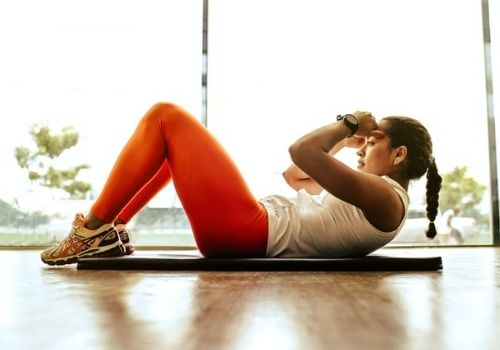
If these calculations are anything to go by, then you’ll need to perform 3000 crunches a day to burn 500 calories to help you burn belly fat!! Wow!
To be honest, I can’t see crunching as the best way to attain that goal. As an isolation workout, crunches will only target one muscle group at a time, making it a low-calorie burner. You might need to include other complementing exercises to help you burn belly fat effectively.
Losing belly fat is one of the most challenging drills in the weight loss journey, so you’ll need to find an exercise that will burn calories significantly.
5 Mistakes to Avoid During a Crunch
- Avoid raising your upper body too high off the floor. Doing so will transfer the workload from the abs to the hip and lower back muscle. This will make the exercise less effective on your abs.
- Do not tuck your chin into your chest or push your head off the floor with your hands. These two actions will bend your neck and cause pain on your neck and upper back. Keep your head and neck in a neutral position.
- Don’t hurry your movements. Execute the movements in slow and controlled motions. Rushing it will make you use momentum instead of engaging muscles as you swing in motion.
- About the surface, make sure it’s not rough or uneven. This will cause both skeletal and muscle injuries.
- Avoid doing crunches without contracting your abdominal muscles. Exerting pressure on these muscles helps to engage them maximally, resulting in an effective workout.
Written by Alisha Wishart – TheHealthPot.com
Certified Personal Trainer (CPT), Writer and Contributor
Alisha, is a Mother, Wife and Certified Personal Trainer (CPT). She understands how demanding everyday life can be and takes great pride in working with individuals and groups to help them achieve their desired fitness goals. Read more about Alisha here.


